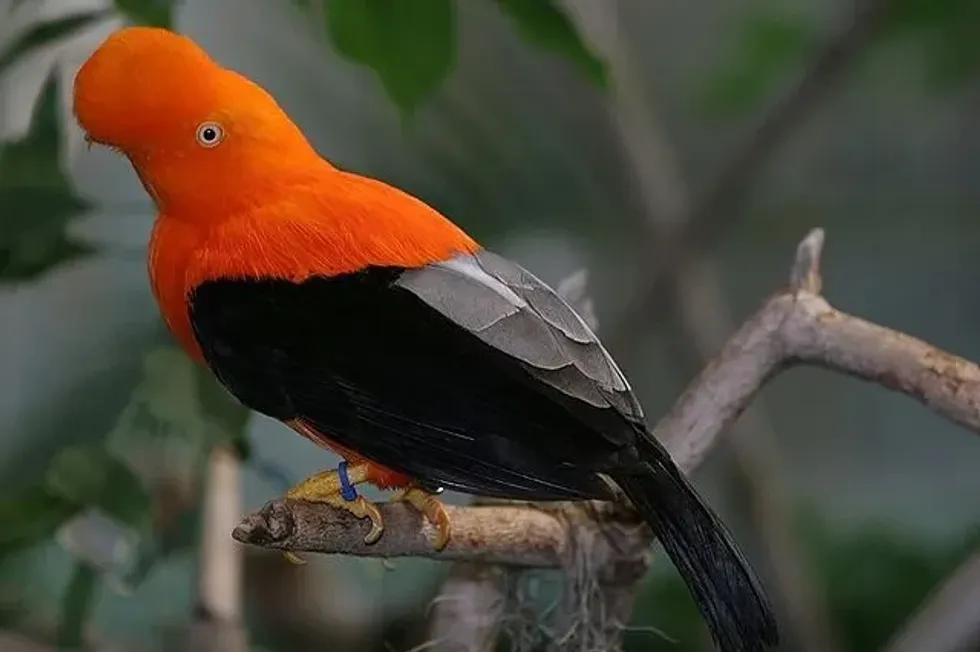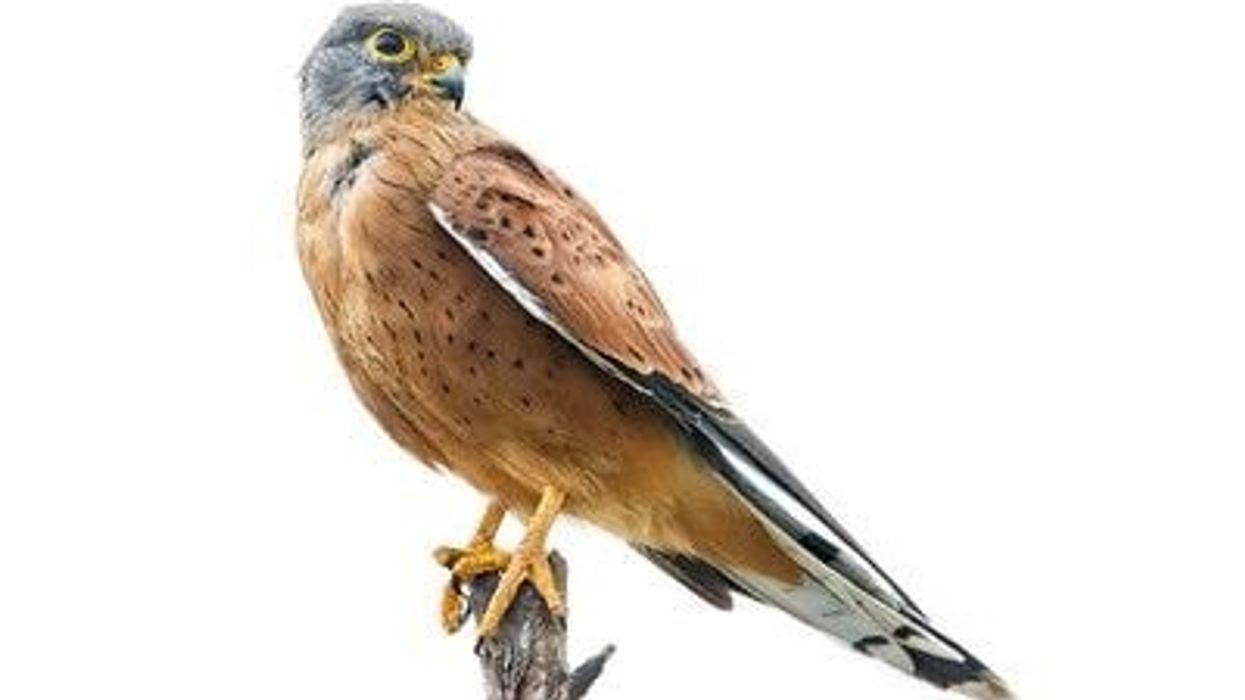The Andean cock of the rock (Rupicola peruvianus) is an iconic passerine bird of the tropical cloud forests of the Andes mountains.
These significantly large birds of the cloud forest are an unmistakable sight; specifically, the males are adorned with a bright orange or crimson plumage and a fan-like crest of feathers on their head that almost obscures their bill.
The females have a dull brown plumage with a relatively small crest of feathers.
Perhaps, the male Andean cock of the rock's prominent crest reminded its namers of a cockerel, and hence the name. The rock in the name comes from the fact that these birds of the cloud forests are frequently found in ravines and rocky cliffs near forest streams.
Besides, the generic name Rupicola has a Latin root that translates to 'rock or cliff inhabiting', justifying the birds' habit of building nests in the walls of rocks.
These birds have four known subspecies - Rupicola peruvianus peruvinaus, Rupicola peruvianus aequatorialis, Rupicola peruvianus sanguinolentus, and Rupicola peruvianus saturatus.
Find these birds with dazzling feathers and fan-like crest interesting? Then read on for more interesting facts about them!
You can learn more about interesting birds like the blue and yellow macaw and the Amazon parrot.
Andean Cock of the Rock Interesting Facts
What type of animal is an Andean cock of the rock?
The Andean cock of the rock (Rupicola peruvianus) of the family Cotingidae is a species of passerine bird native to the cloud forests of the Andes mountains of South America.
What class of animal does an Andean cock of the rock belong to?
The Andean cock of the rock belongs to class Aves that comprises all birds.
How many Andean cock of the rock are there in the world?
The global population of these birds is unknown. According to the International Union for Conservation of Nature (IUCN), the bird has a decreasing population trend.
Where does an Andean cock of the rock live?
The Andean cock of the rock nests in rocky and humid forest areas, particularly in ravines near forest streams.
What is an Andean cock of the rock's habitat?
The Andean cock of the rock's habitat is mostly confined to the cloud forest of the Andes mountains of South America. Their habitat range map includes Peru, Bolivia, Ecuador, Venezuela, and Colombia.
Within this range map, the bird may be found at elevations of up to 1,600-7,900 ft (500-2,400 m) in the Montane forests. The bird typically dwells in the lower and middle forest levels of its habitat.
Who do Andean cock of the rock live with?
The male Andean cock of the rock gathers into a group called a lek. A lek is a congregation of male birds or animals who engage in competitive courtship displays and rituals to entice potential females.
Such a communal gathering is a place where the males and the females choose their prospective mating partners after an impressive display of the orange plumage of the male bird.
How long does an Andean cock of the rock live?
The Andean cock of the rock has an average lifespan of about seven years.
How do they reproduce?
Mating is preceded by an elaborate display of the bright orange plumage of the male in a communal gathering called the lek. During this time, the females survey the display efforts of the competing males in search of a potential mating partner.
In addition, the males try to attract the females with a call that sounds like a squealing pig.
The mating season varies with the geographical location, and a male Andean cock of the rock usually mates with more than one female. The females build a nest of mud in a cave or under a rocky outcrop in which she lays about two eggs.
The eggs are incubated for 25-28 days. After the incubation period of 28 days is over, the chicks hatch and are taken care of by the female. Once mating is over, the male is no longer involved with nesting or rearing the young.
What is their conservation status?
The Andean cock of the rock is of Least Concern in the IUCN Red List of Threatened Species.
Andean Cock of the Rock Fun Facts
What does Andean cock of the rock look like?

The males and females of this bird species have starkly different physical appearances. While the males have a dazzling scarlet or bright orange plumage with a fan-like crest of feathers, the females are duller, with a brownish plumage and smaller crest.
The males' tail and wings are black with a gray scapular.
The bill of the males is bright yellow, and the female bird has a darker bill with a small yellow tip. Besides, the iris color varies with the gender and subspecies and they may be orange, red, yellow, bluish-white, or brown.
How cute are they?
These conspicuous birds look quite cute and adorable with their mohawk-like crest, giving a puffed-up appearance to their feathery orange body.
How do they communicate?
The Andean cock of the rocks can be quite loud and noisy, especially when gathering at the lek. Their characteristic mating call is a pig-like squeal. They also make a wide variety of strange sounds, including croaks and raspy clanks when in flight or at the lek.
How big is an Andean cock of the rock?
The Andean cock of the rock is approximately 13 in (32 cm) long. It is comparable in size to the Guianan cock of the rock.
How fast can an Andean cock of the rock fly?
Andean cock of the rocks are known to have a pretty swift flying speed, though the exact speed is not known.
How much does an Andean cock of the rock weigh?
On average, the Andean cock of the rock weighs about 9 oz (256 g).
What are their male and female names of the species?
Males and females do not have distinct names.
What would you call a baby Andean cock of the rock?
Baby Andean cock of the rocks are called chicks.
What do they eat?
The diet of these birds consists of fruit, berries, and insects. Besides fruit, they have also been reported to consume a diet of frogs and small reptiles.
Are they dangerous?
Andean cocks of the rock are not at all dangerous but rather shy.
Would they make a good pet?
The timid and harmless nature of these birds would make them good pets.
Did you know...
The Andean cock of the rock (Rupicola peruvianus) is one of the two species of the genus Rupicola, the other being the Guianan cock of the rock (Rupicola rupicola).
Courtship displays of the males at the lek also include elaborate gestures such as wing-flapping, bowing, bill-snapping, and head-bobbing.
Andean cock of the rock is the national bird for which country?
The Andean cock of the rock is the national bird of Peru.
What are the other names for Andean cock-of-the-rock?
In the Quechuan language, this species of cock of the rock is also known as a tunki.
Here at Kidadl, we have carefully created lots of interesting family-friendly animal facts for everyone to discover! Learn more about some other birds, including the Senegal parrot and Meyer's parrot.
You can even occupy yourself at home by drawing one of our Andean Cock Of The Rock coloring pages.









